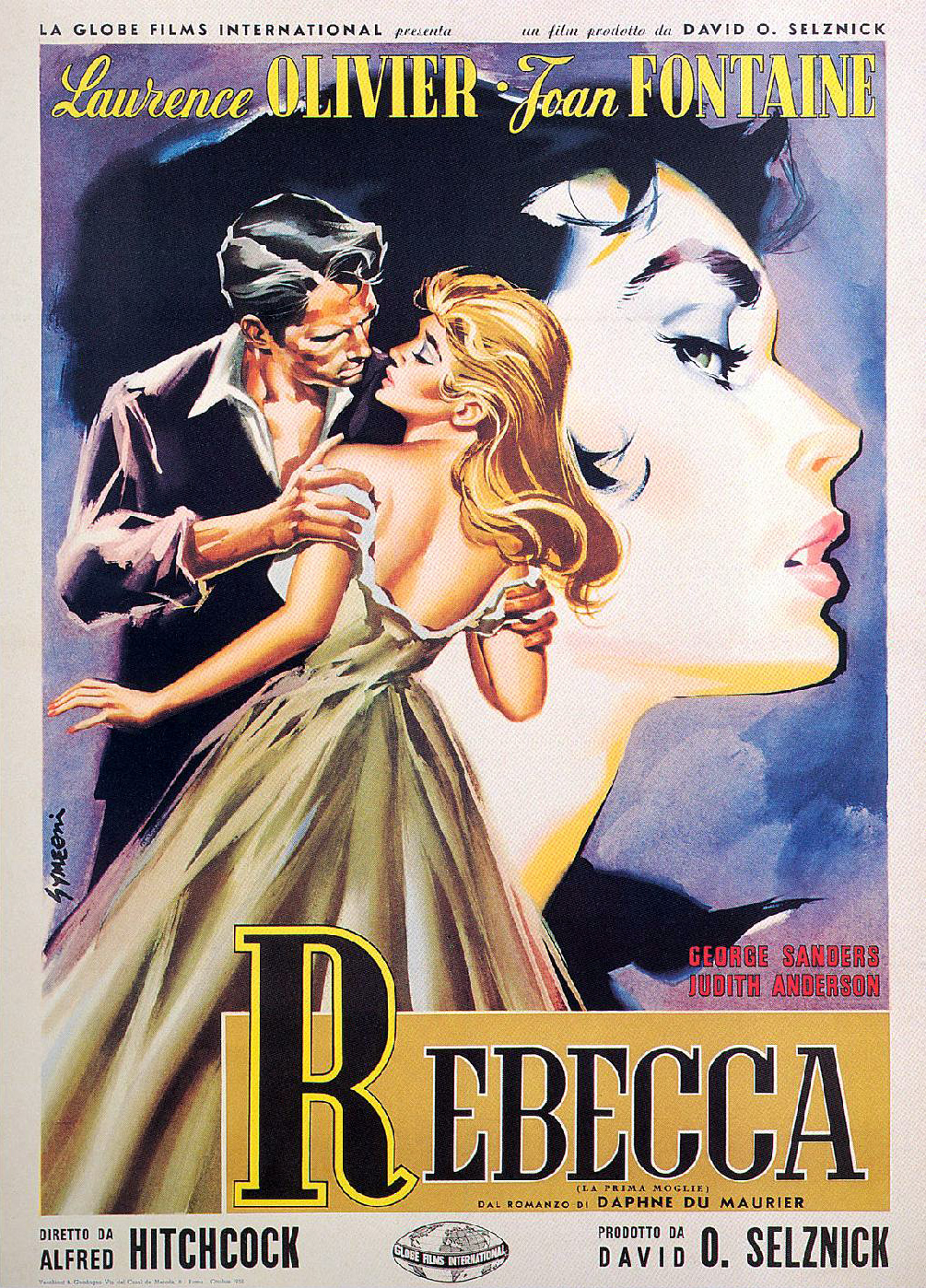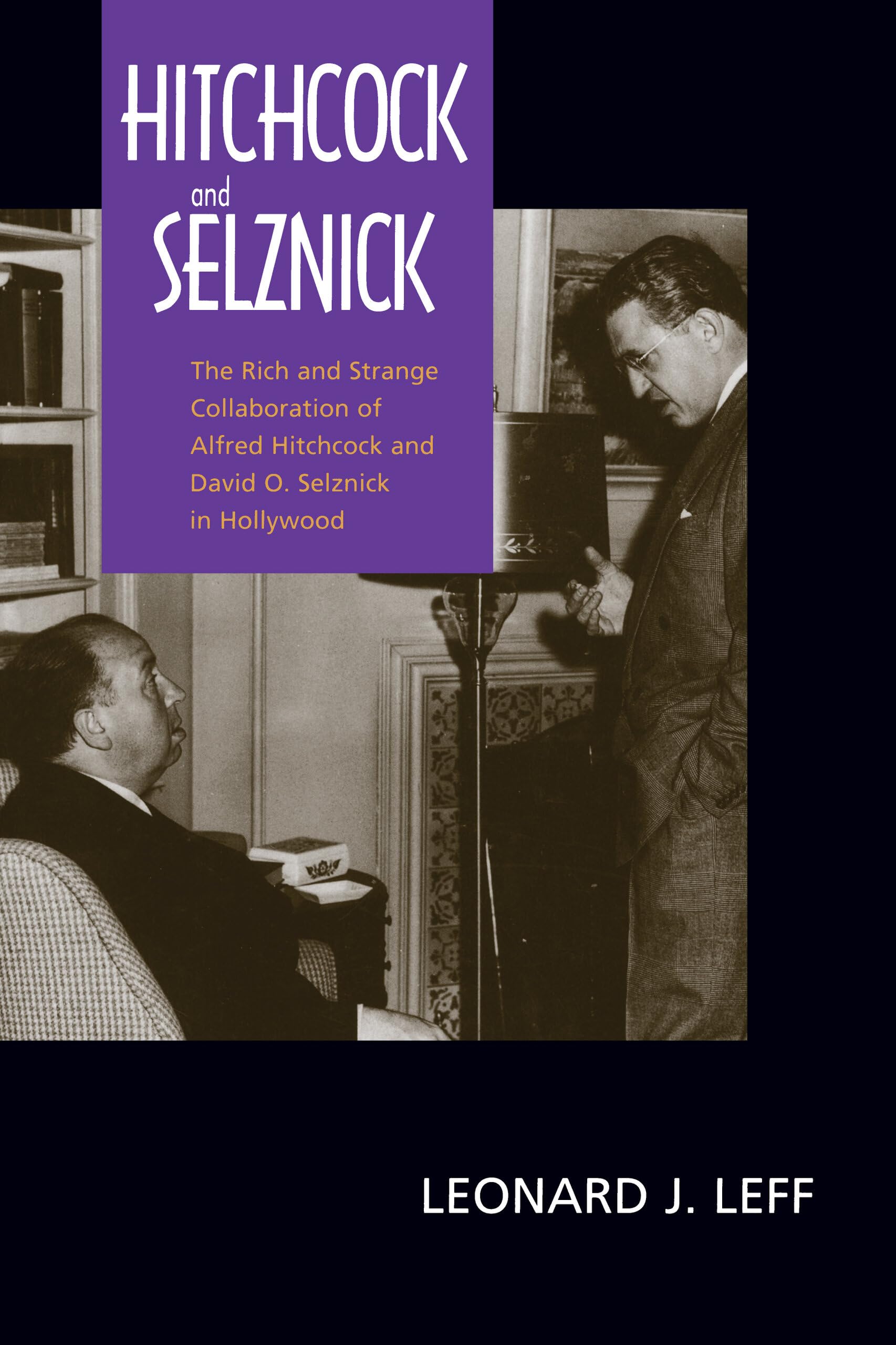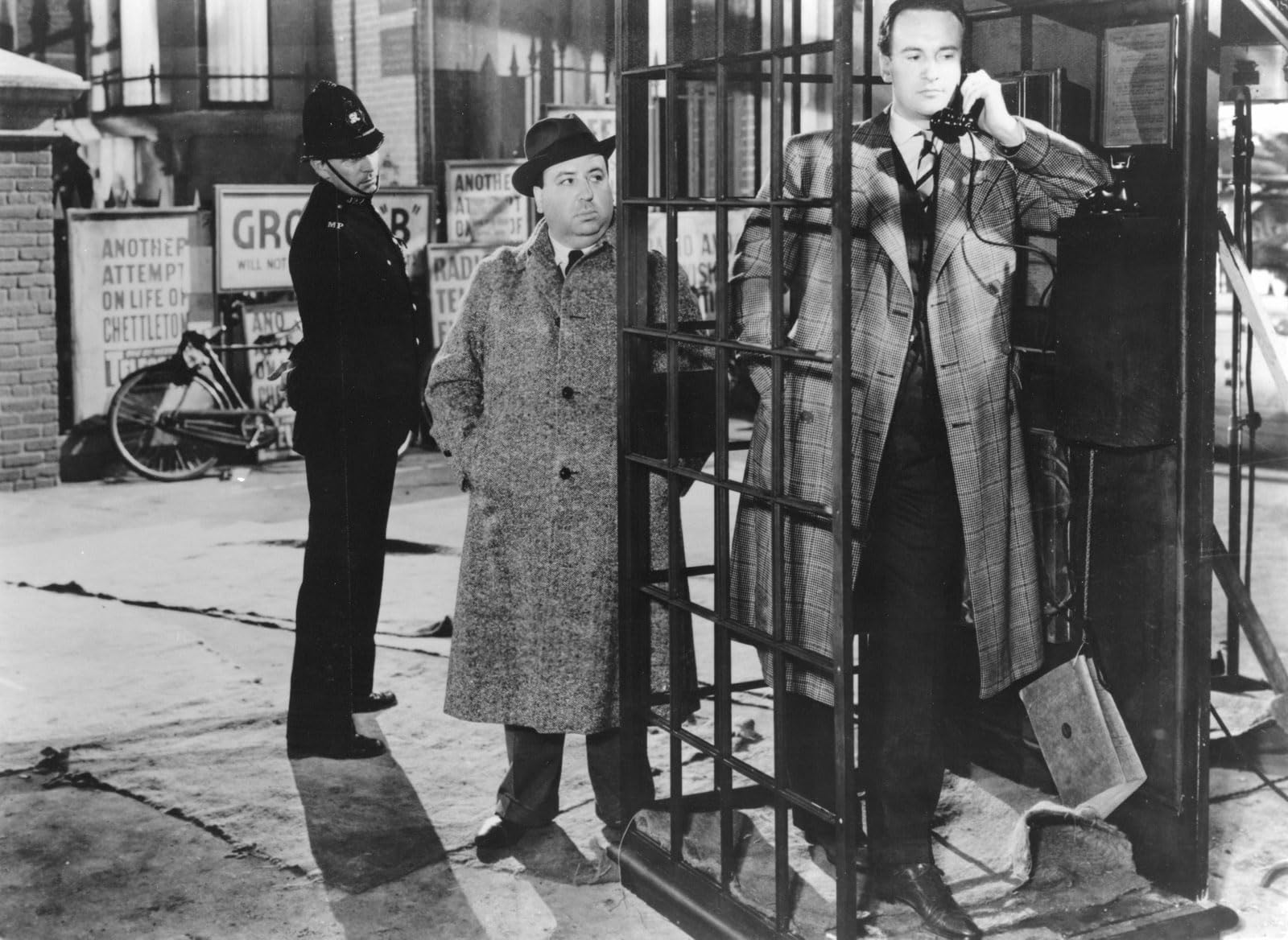- Bonkbuster: The Mistress of Romance meets the Master of Suspense
- Kissing cousins: Rebecca keeps it in the family and births a torrid tale
- Daphne du Maurier’s second bestseller provides basis for gothic melodrama
- First of the Master’s four collaborations with Hollywood über-producer David O. Selznick
- It would eventually be followed by star-powered Spellbound, Notorious and The Paradine Case
- One of 1940’s top-grossing films, it announced Hitch as a major force in American filmmaking
- It was nominated for 11 Academy Awards, winning two: Best Picture and Best Cinematography
Note: this is part of an ongoing series of 150-odd Hitchcock articles; any dead links are to those not yet published. Subscribe to the email list to be notified when new ones appear.
Rebecca: Writing on a Classic; Collectors Guide, Part 2: Production, 3: Home video, 4: 1956 re-release and bootlegs, 5: Soundtrack and radio, 6: Remakes

Though more luridly colourful than truly Gothic, this Italian 1951 re-release poster is much nearer the mark than the one below. Original non-colorized stills here and here.
Contents
Synopsis
↑ 2022 French screening trailer; the 1940 original is lost, though that for the 1956-release is very common.
A timid young girl marries a troubled widower, only to find her new home haunted by the memory of Rebecca—the first Lady de Winter and the ideal wife. The housekeeper, fiercely devoted to Rebecca and her memory, makes the new Lady de Winter’s life a nightmare. Terrified and confused, Mrs. de Winter must discover the secret locked in her husband’s heart—the truth about Rebecca. – US Magnetic Video VHS (1981)
Romance takes a back seat to suspense as the brooding Maxime de Winter sweeps a naïve woman off her feet without realizing that the spirit of his late wife, Rebecca, would implant her memory into their lives. The mystery of Rebecca’s death and the heartbreaking attempts of the new bride to emulate her sophisticated predecessor are interwoven by Hitchcock into an eerie triangle between husband, new bride and the first Mrs. de Winter. – Australian VDI VHS (1993)
- Rebecca – Peter Bradshaw, The Guardian
- My Favourite Hitchcock: Rebecca – Bidisha, The Guardian
- My Favourite Hitchcock: Rebecca – Michael Hann, The Guardian
The novel

Rebecca study guide infographic at Course Hero
Daphne du Maurier’s bestselling 1938 novel is one of the most renowned works in English literature and is also, like its esteemed peers, perennially bolstered by being reincarnated and homaged endless times in every conceivable media. In addition to its many radio, film and TV versions, which we’re most concerned with here, there are several stage plays, the first of which was adapted by the author herself, became a domestic staple and even played on Broadway. Clifford Williams’ retooled play arrived in 1995, followed by Frank McGuinness’s adaptation which first toured throughout 2005 and 2006, and makes “I” of Anglo-Irish descent from a once-privileged family; yet another, by Emma Rice, débuted in 2015. Latterly, it’s even given its name to a common relationship syndrome. Rebecca has arrived and she’s here to stay.
- Love to death: Hitchcock, Du Maurier and Rebecca – Alison Light
- Literary greats: Rebecca – Love, paranoia, obsession – Liz Hoggard
Daphne du Maurier and Alfred Hitchcock – Richard Allen
There’s even a 1983 opera (audio), a controversial but international hit musical from 2006, and so on. And on. But Rebecca’s story was nothing new in literary terms; in fact the evidence is pretty compelling that du Maurier actually stole it. So far, so unoriginal; she was also unsuccessfully sued by another author of a similar story. The only real magic is in the way du Maurier told it. Also essential is du Maurier’s belated companion volume, The Rebecca Notebook (1981), featuring her fascinating contemporary notes on the gestation and initial reception of the novel, and a previously unpublished epilogue. For those hungry for even more, there are also three authorised but long-belated sequels by other authors:
- Mrs de Winter (1993) – Susan Hill
- The Other Rebecca (1996) – Maureen Freely
- Rebecca’s Tale (2001) – Sally Beauman
This was, of course, Hitch’s second du Maurier adaptation, sandwiched between Jamaica Inn and his third, The Birds, which was also of very questionable provenance. Incidentally, Josephine Tey, real-life author of A Shilling for Candles (1936), the source novel for Hitch’s Young and Innocent, has latterly been recast as the detective star of a series of bestselling novels by British author Nicola Upson. Her fifth entry in the series, Shot with Crimson (2023), sees Tey taking on a transatlantic crime connected with the creation of both du Maurier’s Rebecca and Hitch’s screen version. On a related note, prolific American author Jayne Ann Krentz writes under several pseudonyms including Amanda Quick, via which she’s published a series of bestselling novels set in the fictional 1930s town of Burning Cove, California (a possible nod to Jessica Fletcher’s Cabot Cove, Maine). Both in their titles and themes, all pay obvious homage to Hitchcock:
- The Girl Who Knew Too Much (2017)
- The Other Lady Vanishes (2018)
- Tightrope (2019)
- Close Up (2020)
- The Lady Has a Past (2021)
- When She Dreams (2022)
- The Bride Wore White (2023)

Rebecca by Daphne du Maurier, Virago 80th anniversary edition
In 2018, the 80th anniversary of Rebecca the novel was marked with a commemorative edition, followed by a special screening and panel discussion. The previous year, Expanded Hitchcock screened the then new 2017 restoration followed by a discussion with Tania Modleski, author of the hugely influential The Women Who Knew Too Much: Hitchcock and Feminist Theory (1983). Then 2022 saw the (Covid-delayed) Rebecca at 80 conference featuring two days of presentations from many of the world’s leading Hitch and du Maurier experts, and a 35mm print screening.
- Rebecca: A Gothic Romance by DdM and AH (2018) – Leland Poague
Hitchcock/Selznick
- Hitchcock and Selznick: Their Rich and Strange Collaboration in Hollywood (1987/1999) – Leonard J. Leff | review
- Rebecca: The Making of a Hollywood Classic (2013) – Jennifer Leigh Wells
- Rebecca (2017) – Jean-Loup Bourget | interview
- Rebecca (2021) – Patricia White | interview, #2
Rebecca was, of course, the opening salvo in the fraught, four-film Hitchcock-Selznick partnership, the others being Spellbound, Notorious and The Paradine Case. Though all get a good mention in any decent book about Hitchcock – and there are a fair few! – for more background and insight these deal the most squarely with both Rebecca and her siblings, while the following essays are crammed with fascinating details.
- Rebecca – Dennis Grunes
- Brand-Name Literature: Film Adaptation and Rebecca – Kyle Edwards
In these days of almost unfettered access to multimedia materials on major works such as Rebecca – there are over a dozen hours of A/V extras on the restored releases alone – it’s easy to forget ’twas not ever thus. A sign of things to come arrived with The Rebecca Project CD-Rom (1995), widely considered to be the first such release in the area of film studies. It “contains [60-plus] QuickTime movie clips, photographs, critical essays (with hypertext), and rarely seen primary documents.
Designed for interactive, flexible use in developing and improving skills in cinema analysis, history, and criticism through the examination of a single movie. Provides information on the film industry, women’s studies, American cultural history, and of how Alfred Hitchcock and Selznick addressed American female audiences on the eve of World War II.” Here’s a detailed review and preservation assessment; interestingly, it was followed by a similar project at MoMA’s 1999 Hitchcock exhibition.
- Taking the Rocky Road to Manderley – Ian Johns
- Last Night I Went to Manderley Again – Ken Mogg
- Du Maurier + Selznick + Hitchcock = Rebecca – George E. Turner
In this publicity still (alt, still/re-release) of Hitch’s cameo alongside George Sanders, playing Rebecca’s cousin and lover, note the pieces of carpet spread over the concrete studio floor to deaden unwanted footsteps. Hitch’s fleeting appearance in the actual film is much more discreet, although at least one report had him playing the policeman.
Some erroneous sources claim said officer is an uncredited Billy Bevan but the 5′5½” Aussie was 52 at the time of filming and already looking much older and more portly than the person here. A former vaudevillian, he went on to appear in dozens of silent film comedies before forging an enduring career as a character actor until the early 1950s, including as the train ticket collector distinctly unimpressed with Cary Grant’s fare-dodging antics in Suspicion. This comprehensive restored and region free collection is highly recommended:
- US: D&D 2-BD Billy Bevan: Silent Comedian (2024) videos

While admittedly striking, this typically sexed-up Italian 1958 re-release poster (orig) by Sandro Symeoni bears little relation to the actual film or its characters, instead evoking the artwork of Selznick’s previous success, Gone with the Wind (1939).
Rebecca: Writing on a Classic; Collectors Guide, Part 2: Production, 3: Home video, 4: 1956 re-release and bootlegs, 5: Soundtrack and radio, 6: Remakes
Related articles
This is part of a unique, in-depth series of 150-odd Hitchcock articles.



Bravo! Such a thrill to finally read this!
I do respectfully note, though, that the links to part 4, 5, and 6 in the index at the top and bottom of the article do not resolve correctly.